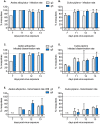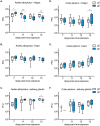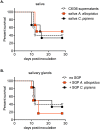European Aedes albopictus and Culex pipiens Are Competent Vectors for Japanese Encephalitis Virus
- PMID: 28085881
- PMCID: PMC5268654
- DOI: 10.1371/journal.pntd.0005294
European Aedes albopictus and Culex pipiens Are Competent Vectors for Japanese Encephalitis Virus
Abstract
Background: Japanese encephalitis virus (JEV) is the causative agent of Japanese encephalitis, the leading cause of viral encephalitis in Asia. JEV transmission cycle involves mosquitoes and vertebrate hosts. The detection of JEV RNA in a pool of Culex pipiens caught in 2010 in Italy raised the concern of a putative emergence of the virus in Europe. We aimed to study the vector competence of European mosquito populations, such as Cx. pipiens and Aedes albopictus for JEV genotypes 3 and 5.
Findings: After oral feeding on an infectious blood meal, mosquitoes were dissected at various times post-virus exposure. We found that the peak for JEV infection and transmission was between 11 and 13 days post-virus exposure. We observed a faster dissemination of both JEV genotypes in Ae. albopictus mosquitoes, when compared with Cx. pipiens mosquitoes. We also dissected salivary glands and collected saliva from infected mosquitoes and showed that Ae. albopictus mosquitoes transmitted JEV earlier than Cx. pipiens. The virus collected from Ae. albopictus and Cx. pipiens saliva was competent at causing pathogenesis in a mouse model for JEV infection. Using this model, we found that mosquito saliva or salivary glands did not enhance the severity of the disease.
Conclusions: In this study, we demonstrated that European populations of Ae. albopictus and Cx. pipiens were efficient vectors for JEV transmission. Susceptible vertebrate species that develop high viremia are an obligatory part of the JEV transmission cycle. This study highlights the need to investigate the susceptibility of potential JEV reservoir hosts in Europe, notably amongst swine populations and local water birds.
Conflict of interest statement
The authors have declared that no competing interests exist.
Figures






Similar articles
-
Susceptibility of Aedes albopictus and Culex quinquefasciatus to Japanese encephalitis virus.Parasit Vectors. 2022 Jun 16;15(1):210. doi: 10.1186/s13071-022-05329-0. Parasit Vectors. 2022. PMID: 35710580 Free PMC article.
-
The emerged genotype I of Japanese encephalitis virus shows an infectivity similar to genotype III in Culex pipiens mosquitoes from China.PLoS Negl Trop Dis. 2019 Sep 26;13(9):e0007716. doi: 10.1371/journal.pntd.0007716. eCollection 2019 Sep. PLoS Negl Trop Dis. 2019. PMID: 31557156 Free PMC article.
-
Evaluating the competence of the primary vector, Culex tritaeniorhynchus, and the invasive mosquito species, Aedes japonicus japonicus, in transmitting three Japanese encephalitis virus genotypes.PLoS Negl Trop Dis. 2020 Dec 28;14(12):e0008986. doi: 10.1371/journal.pntd.0008986. eCollection 2020 Dec. PLoS Negl Trop Dis. 2020. PMID: 33370301 Free PMC article.
-
The Potential Use of Wolbachia-Based Mosquito Biocontrol Strategies for Japanese Encephalitis.PLoS Negl Trop Dis. 2015 Jun 18;9(6):e0003576. doi: 10.1371/journal.pntd.0003576. eCollection 2015. PLoS Negl Trop Dis. 2015. PMID: 26086337 Free PMC article. Review.
-
Meta-analyses of the proportion of Japanese encephalitis virus infection in vectors and vertebrate hosts.Parasit Vectors. 2017 Sep 7;10(1):418. doi: 10.1186/s13071-017-2354-7. Parasit Vectors. 2017. PMID: 28882172 Free PMC article.
Cited by
-
Japanese B Encephalitis.Indian J Crit Care Med. 2021 May;25(Suppl 2):S171-S174. doi: 10.5005/jp-journals-10071-23843. Indian J Crit Care Med. 2021. PMID: 34345134 Free PMC article.
-
Perspectives of vector management in the control and elimination of vector-borne zoonoses.Front Microbiol. 2023 Mar 21;14:1135977. doi: 10.3389/fmicb.2023.1135977. eCollection 2023. Front Microbiol. 2023. PMID: 37025644 Free PMC article. Review.
-
Relevant Day/Night Temperatures Simulating Belgian Summer Conditions Reduce Japanese Encephalitis Virus Dissemination and Transmission in Belgian Field-Collected Culex pipiens Mosquitoes.Viruses. 2023 Mar 16;15(3):764. doi: 10.3390/v15030764. Viruses. 2023. PMID: 36992473 Free PMC article.
-
Identifying sources, pathways and risk drivers in ecosystems of Japanese Encephalitis in an epidemic-prone north Indian district.PLoS One. 2017 May 2;12(5):e0175745. doi: 10.1371/journal.pone.0175745. eCollection 2017. PLoS One. 2017. PMID: 28463989 Free PMC article.
-
Belgian Anopheles plumbeus Mosquitoes Are Competent for Japanese Encephalitis Virus and Readily Feed on Pigs, Suggesting a High Vectorial Capacity.Microorganisms. 2023 May 25;11(6):1386. doi: 10.3390/microorganisms11061386. Microorganisms. 2023. PMID: 37374888 Free PMC article.
References
-
- Fischer M, Hills S, Staples E, Johnson B, Yaich M, Solomon T, et al. Japanese encephalitis prevention and control: advances, challenges, and new initiatives,. In: W M H S, H JM, editors. Emerging infections. 8. Washington, DC: American Society for Microbiology; 2008. p. 93–124.
Publication types
MeSH terms
Substances
LinkOut - more resources
Full Text Sources
Other Literature Sources
Molecular Biology Databases

